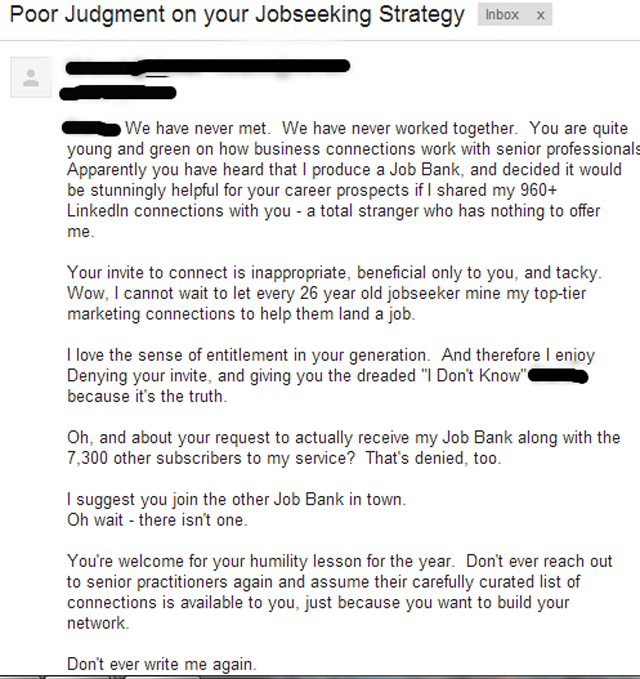Subscribe: Apple Podcasts | Android | RSS
Martin Waxman is back and we are grateful because he is much better at the intro and closing than Joe Thornley and me.
We kick the show off by talking about the Kelly Blazek crisis situation that happened a couple of weeks ago.
As a quick refresher (or the story, for those of you who missed it), the 2013 Cleveland Communicator of the Year received an email from a young professional who is moving to Ohio and searching for a job.
Because Blazek runs the 7,300 member marketing job board for the Cleveland area, this young woman sent her a LinkedIn message, explaining who she was, her business expertise, and what kinds of jobs she could do. She then asked to join the jobs board.
What she received from Blazek, in return, was both unprofessional and … strange … for a communicator.
While we don’t beat this horse to death, it did create an interesting conversation about LinkedIn and how we each use the tool.
As it turns out, we have three different uses for it: Ambivalence, referrals, and contact management, which makes it an interesting look at how there really is no right way or wrong way to use social media. Except to not take your bad day out on someone asking or help.
Martin also mentions he hates the generic LinkedIn requests. You know the one. The, “I’d like to add you to my professional network” with no mention on how you know the person or why you’d like to connect.
He also talks about his pet peeve, which is people who have never worked with you asking you to write a recommendation.
After you listen, we leave the floor to you. What are your personal rules about LinkedIn connections?
P.S. While Terry Fallis’s new book, No Relation, doesn’t come out until May, as is his modus operandi, he is podcasting it for you ahead of time. Check it out!
************************************************************************************************
We’d love to hear your thoughts.
Inside PR is part of the FIR Podcast Network.
Send us an email or an audio comment to [email protected], join the FIR Google+ Community, join the Inside PR Google+ Community, join the Inside PR Facebook group, leave us a comment here, message us @inside_pr on Twitter, or connect with Gini Dietrich, Joseph Thornley, and Martin Waxman on Twitter.
Thank you to the people behind Inside PR
Our theme music was created by Damon de Szegheo; Roger Dey is our announcer.
Inside PR is produced by Kristine D’Arbelles and Ashlea LeCompte.


I love LinkedIn as a business building tool. While the contact management aspect is certainly helpful, I find the Groups to be a terrific resource for information sharing. It took a while to cull through Groups to find those that are focused on the members, but I’m now active on a handful that have provided me with clients, referral partners and interesting professionals.
I teach via workshops and webinars and conduct in-house training on many online tools, one of which is LinkedIn. The first thing I teach participants is how to request a connection. And like Martin, I dislike the generic connection request and show the participants how to treat your new connection like a human being. But I also take it one step further. Rather than pitch your message right after connecting, why not request a networking call on the telephone? And, once you have them on the phone, don’t pitch, but ask the types of questions you would ask if you were attending a live business networking event. Ultimately, I’m trying to teach that the profile you want to connect with is a person and needs to be treated as such.
The only Recommendations I write are for those people that I want my name attached to. If I don’t know you, don’t know your work, don’t know your capabilities, then I won’t write a Recommendation.
As for Kelly Blazek, for a moment I felt sorry for the student that attempted to connect with her and received such a rude response – but only for a moment, because then the student ‘outed’ Kelly rather than handle it privately. To me, it was obvious that Kelly had been experiencing fumbling and rude attempts to connect, had been taken advantage of, and was simply worn out.
Her response was rude and inappropriate, and her follow up was on point and adequate. My view? She’s human and made a mistake that she took responsibility for and apologized. She handled herself professionally. Now I’m waiting for the student response – was it just as professional?
You really provided a summary and analysis of the “Kellygate” situation. I spent a bit of time talking about that myself from a crisis management and personal branding standpoint here: http://caseybraun.com/how-one-email-can-destroy-your-personal-brand-starring-kelly-blazek/
Regarding LinkedIn, I, of course, only have the perspective of a practitioner-in-training seeking connections. As a graduate student studying PR, LinkedIn is a useful resource as far as advice and internship-hunting is concerned. I have to agree with Mr. Waxman in that it is important to personalize the “I’d like to add you to my professional network” invitation.
Thinking back to manner in which I often meet seasoned professionals, it is usually via a professor’s connection or at a conference of some kind. That being said, it is always important to remind professionals where they met you, who you are and what you discussed with them by way of a personalized message.
Further, I am interested in hearing your opinions on the notion of an in-person LinkedIn request. Often, when I meet professionals, I will ask them if I can add them on LinkedIn when I return to my computer. I usually get a positive responses from this request; however, I imagine that could also be a really awkward question to receive in-person.
Thank you for the work you do on the podcasts.